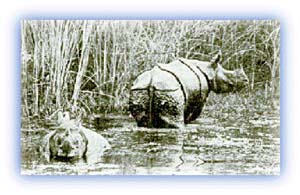Nepal Himalayas
General Info
· Solo Khumbu
· Namche Bazar
· Thyangboche
· Pangboche
· Kalapattar
· Pheriche
· Buddhism in Khumbu
· People: Sherpas
· Mount Everest
· The Quest for Everest
· Early Years
· The 1950s
· Sherpas on Everest
· Central Nepal
· Mustang
· Jomsom
· People: Thakalis
· Muktinath
· Manang valley
· Bryagu village
· Manang village
· Nyasang Division
· Western Nepal
· Jumla
· Sukhadik
Photo Feature:
· Annapurna region
High Altitude Sickness
Protected Areas
Yaks
The Yeti Factor

![]()
|
Endangered Species From 1950 to 1980 Nepal lost half of its forest cover to make room for its population that had doubled during the period. Today, less than 30% of the total land is covered by forests. Moreover, the practise of subsistence farming has put great pressure on the forest lands and wild animals. These, accompanied by the increasing problems of poaching have meant that several species of animals have become endangered. |
 |
| Panthera Tigris Credit: Karamjeet Singh |
Tigers
Tigers and leopards are killed for their superb coats and
bones. The bones are used in Chinese and Japanese traditional
medicine. There is a rising demand for tiger related goods.
Tiger skins and bones are in strong demand. Poachers and
smugglers have established a clever route by which tigers
surface in the form of medicines and balms in Chinese markets
as Chinese "medicine". Not a year goes by without stories of
seizures of bones and skins by customs officials. But these
seizures are only the tip of the iceberg and the poaching still
continues.
Musk Deer
Musk deer are hunted for musk, a powdery substance which the
male musk deer secretes from a gland in the abdomen. This is a
highly valued item for perfumes and medicines. Chinese use the
musk as a folk medicine and believe it has aphrodisiac
properties.
 |
| One-horned Rhinoceros Credit: Mahabir Pun |
Himalayan Black Bear
The Himalayan Black Bear is also endangered. The animals are
killed for their gall bladder, which provides the ingredients
of one of the most coveted oriental medicines.
Other endangered species include the one-horned Rhinoceros, the Wild Water Buffalo, Swamp Deer, Pygmy Hog, Wild Elephant, Hispid Hare, Wild Yak, Snow Leopard, Red Panda and the Gharial Crocodile.
All rights reserved